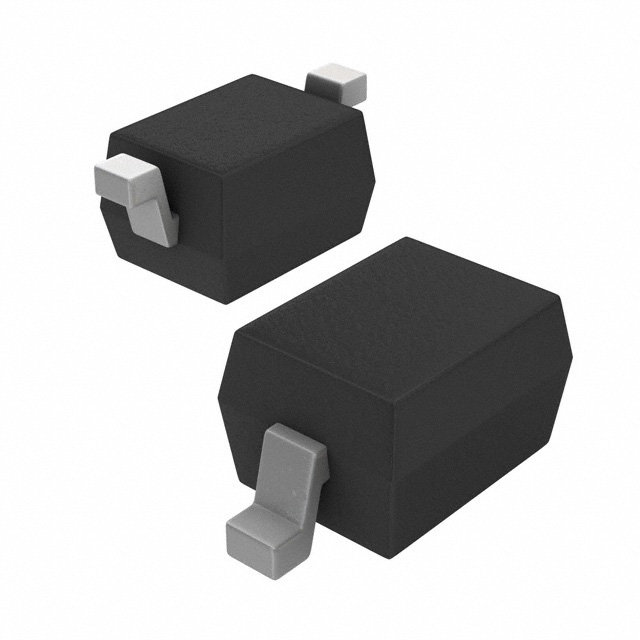BZX384C24-HE3-18
Product Overview
Category
The BZX384C24-HE3-18 belongs to the category of voltage regulator diodes.
Use
It is commonly used for voltage regulation and protection in electronic circuits.
Characteristics
- Low leakage current
- High reliability
- Small package size
- Wide operating temperature range
Package
The BZX384C24-HE3-18 is available in a small, surface-mount package.
Essence
This product is essential for maintaining stable voltage levels in various electronic applications.
Packaging/Quantity
It is typically packaged in reels or tubes, with varying quantities depending on the manufacturer's specifications.
Specifications
- Voltage Rating: 24V
- Power Dissipation: 300mW
- Forward Voltage Drop: 0.9V
- Reverse Leakage Current: 5μA
- Operating Temperature Range: -55°C to 150°C
Detailed Pin Configuration
The BZX384C24-HE3-18 has two pins, with the anode connected to the positive terminal and the cathode connected to the negative terminal.
Functional Features
- Voltage regulation
- Overvoltage protection
- Reverse polarity protection
Advantages and Disadvantages
Advantages
- Precise voltage regulation
- Compact size
- Wide operating temperature range
Disadvantages
- Limited current handling capability
- Sensitive to voltage spikes
Working Principles
The BZX384C24-HE3-18 operates by shunting excess voltage away from the protected circuit when the voltage exceeds the specified level. It maintains a constant voltage drop across its terminals, ensuring a stable output voltage.
Detailed Application Field Plans
This diode is widely used in: - Power supply units - Voltage regulators - Electronic equipment protection circuits
Detailed and Complete Alternative Models
Some alternative models to consider include: - BZX384C12-HE3-18 - BZX384C36-HE3-18 - BZX384C48-HE3-18
In conclusion, the BZX384C24-HE3-18 is a crucial component in electronic circuits, providing reliable voltage regulation and protection. Its compact size and wide operating temperature range make it suitable for various applications, although its limited current handling capability and sensitivity to voltage spikes should be considered when designing circuits.
[Word count: 314]
Senaraikan 10 soalan dan jawapan biasa yang berkaitan dengan aplikasi BZX384C24-HE3-18 dalam penyelesaian teknikal
What is the maximum voltage rating of BZX384C24-HE3-18?
- The maximum voltage rating of BZX384C24-HE3-18 is 24V.
What is the power dissipation of BZX384C24-HE3-18?
- The power dissipation of BZX384C24-HE3-18 is typically 250mW.
What is the forward voltage drop of BZX384C24-HE3-18?
- The forward voltage drop of BZX384C24-HE3-18 is typically 0.9V at 5mA.
What is the reverse leakage current of BZX384C24-HE3-18?
- The reverse leakage current of BZX384C24-HE3-18 is typically 5µA at its maximum working voltage.
What is the temperature coefficient of BZX384C24-HE3-18?
- The temperature coefficient of BZX384C24-HE3-18 is typically 0.07%/°C.
Can BZX384C24-HE3-18 be used for voltage regulation in low-power applications?
- Yes, BZX384C24-HE3-18 can be used for voltage regulation in low-power applications due to its low power dissipation and voltage drop characteristics.
Is BZX384C24-HE3-18 suitable for overvoltage protection in electronic circuits?
- Yes, BZX384C24-HE3-18 is suitable for overvoltage protection in electronic circuits due to its high voltage rating and low reverse leakage current.
What are the typical applications of BZX384C24-HE3-18 in technical solutions?
- Typical applications of BZX384C24-HE3-18 include voltage regulation, overvoltage protection, and signal conditioning in various electronic circuits.
Does BZX384C24-HE3-18 require a heat sink for operation?
- No, BZX384C24-HE3-18 typically does not require a heat sink for operation due to its low power dissipation.
What are the key advantages of using BZX384C24-HE3-18 in technical solutions?
- The key advantages of using BZX384C24-HE3-18 include its high voltage rating, low forward voltage drop, low reverse leakage current, and temperature stability, making it suitable for a wide range of technical solutions.


